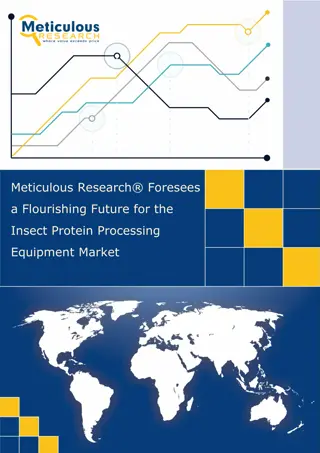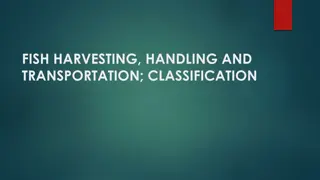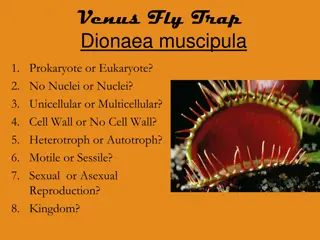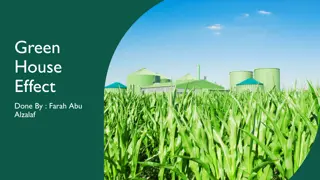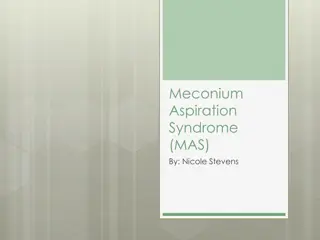Insect Abdominal Structures and Appendages: An Overview
The abdomen of insects plays crucial roles in respiration, reproduction, digestion, excretion, and metabolism. The number of abdominal segments varies across species, with reductions and modifications seen in different insect groups. From the propodeum to pregential and postgenital segments, each pa
1 views • 6 slides
Sustainable Rice Production in Pakistan: Challenges and Strategies
Pakistan's economy heavily relies on rice exports, with the country being a significant producer and exporter. However, challenges such as pesticide residues, major insect pests, and diseases threaten rice production. Key parameters for production include cultivation of improved varieties, pest mana
2 views • 42 slides
Insect Identification for FFA Agronomy Skills Contest
Explore a variety of insects including the Alfalfa Weevil, Aphid, Army Worm, Assassin Bug, Bean Leaf Beetle, Black Cutworm, Chinch Bug, Colorado Potato Beetle, Common Stalk Borer, Corn Earworm, Corn Rootworm, Cricket, Cucumber Beetle, European Corn Borer, Flea Beetle, Grasshopper, Green Lacewing, Gr
1 views • 37 slides
Navigating the New Horizons: Rediscovering the Insect Protein Market Dynamics
According to BIS Research, the Global Insect Protein Market was estimated to be at $342.87 million in 2021, which is expected to grow with a CAGR of 26.49% and reach $1,386.55 million by 2027.
2 views • 2 slides
Insect Protein Processing Equipment Market Worth $210.6 Million by 2029
The insect protein processing equipment market is driven by innovations in insect protein processing equipment, the increasing focus of insect protein manufacturers to reduce production costs, increased investments in the insect-based protein industry, and the rising demand for insect protein in the
0 views • 3 slides
Asian Hornets
Explore the differences between Asian and European hornets, learn how to identify Asian hornets, understand their life cycle, monitor designs for detection, and know what to do if you encounter them. Discover essential information on Asian hornet sightings, nest behavior, and effective trapping tech
0 views • 9 slides
Overview of Fish Harvesting, Handling, and Transportation
Fish harvesting is crucial for providing valuable animal protein, with India being a key player in fish production. Fisheries are categorized into fin and non-fin types, with capture and culture fisheries being common practices. Capture fisheries involve natural species recruitment in sea and inland
2 views • 16 slides
Understanding Non-Insect Pests in Agriculture
In this lecture, we delve into important non-insect pests affecting agriculture, such as nematodes, mites, snails, slugs, crabs, millipedes, birds, rodents, and more. Learn about their systematic positions, damages they cause, and characteristics. Explore the world of millipedes and centipedes, thei
0 views • 15 slides
Understanding the Thyroid Gland: Functions and Hormone Synthesis
The thyroid gland is a vital endocrine gland located below the larynx, responsible for producing thyroid hormones essential for regulating metabolism. This gland consists of follicles lined with follicular cells, producing thyroglobulin and thyroid hormones T3 and T4. Iodine plays a crucial role in
0 views • 40 slides
Insect Repellent Market: Strategies for Success in a Competitive Market
The Global Insect Repellent Market size is expected to be worth around USD 26 Billion by 2033, from USD 5 Billion in 2023, growing at a CAGR of 6.9% during the forecast period from 2023 to 2033.\n\nClick here for requesting a sample : \/\/market.us\/
1 views • 3 slides
Insect Pests of Citrus: Identification, Behavior, and Management
Insect pests such as citrus butterfly, fruit-sucking moth, leaf miner, rust mite, and bark-eating caterpillar pose significant threats to citrus plants. These pests can damage citrus seedlings and various fruit varieties. Understanding their appearance, distribution, life cycle, and management techn
4 views • 14 slides
Understanding the Fascinating World of Insect Antennae
Insect antennae, also known as feelers, play a crucial role in sensory perception for insects. They help in detecting chemicals, perceiving various stimuli, and even aid in specialized functions like communication and prey-catching. The structure of antennae varies across insect species, showcasing
0 views • 11 slides
Insect Circulatory System: Overview and Functions
The insect circulatory system comprises an open type, where blood flows through the body cavity. Divided into three sinuses, it houses vital organs such as the heart and nerve cord. The dorsal vessel acts as the main organ of circulation, along with accessory pulsatile organs that supply blood to ap
0 views • 19 slides
Understanding Regulatory Requirements for Pesticide Devices
Pesticide devices, as defined by FIFRA, play a crucial role in trapping, destroying, repelling, or mitigating pests or plant and animal life. While not required to be registered with the EPA, these devices are regulated under FIFRA sections 2(q)(1), 7, and 8, with specific labeling and packaging req
0 views • 10 slides
Investigating Mosquito Attractants for Effective Trapping in Queens
Mosquitoes are vectors for spreading diseases, prompting a study to test the effectiveness of various attractants in trapping them. Results indicate carbon dioxide and lights are effective attractants, while KCl did not attract mosquitoes. The study aims to develop targeted traps for efficient mosqu
0 views • 4 slides
Understanding Insect Legs: Anatomy and Adaptations
Explore the intricate anatomy of insect legs, comprising segments like coxa, trochanter, femur, tibia, and tarsus, each serving specific functions for locomotion. Discover how these legs are adapted for diverse tasks like walking and running in different insect species.
0 views • 18 slides
Utilizing Sterile Insect Technique for Aedes Aegypti Control
The Sterile Insect Technique (SIT) is a biologically-based method used to manage key insect pests by releasing sterile insects to decrease population reproduction. This technique, developed through genetic manipulation and ionizing radiation, has been instrumental in controlling insect populations l
0 views • 13 slides
The Fascinating Venus Fly Trap - A Carnivorous Plant
The Venus Fly Trap, scientifically known as Dionaea muscipula, is a unique carnivorous plant found in the southern swamps of the US. It is a eukaryotic, multicellular autotroph that thrives in poor, nutrient-deficient soils by capturing insects for essential nutrients like nitrogen. Its trapping mec
0 views • 12 slides
Understanding Renal Block: Drugs, Excretion, and Treatment Essentials
Renal block plays a crucial role in drug excretion, with processes like glomerular filtration and tubular secretion affecting drug elimination. Factors like blood flow, physiochemical properties, and urine pH influence renal excretion of drugs. Competition between drugs for transporters can have ben
0 views • 10 slides
Insect Farming Market
The global Insect Farming Market size is expected to be worth around USD 2 billion by 2033, from USD 1.5 billion in 2023, growing at a CAGR of 4.3% during the forecast period from 2023 to 2033.\nClick here for request a sample: \/\/market.us\/report\
1 views • 4 slides
Understanding Noise in RF Integrated Circuits: Thermal and 1/f Noise
Noise, an unwanted input, limits a system's ability to process weak signals. Sources of noise include random noise in resistors and transistors, mixer noise, undesired cross-coupling noise, and power supply noise. Thermal noise, caused by thermal agitation of charge carriers, is also known as Johnso
1 views • 49 slides
Taking Action on Climate Change Today
Our everyday actions contribute to climate change through CO2 trapping sunlight. It is essential to start making changes now, such as expressing opinions, active listening, creativity, and team building. Questions on emissions, social equity, and global strategies for change are crucial. The crisis
0 views • 5 slides
Understanding the Greenhouse Effect and Its Impact
The greenhouse effect is the trapping of the sun's warmth in a planet's lower atmosphere, primarily by greenhouse gases like carbon dioxide and water vapor. These gases absorb and re-emit infrared radiation, which leads to an increase in temperatures. While carbon dioxide and water vapor are signifi
1 views • 13 slides
Understanding Global Warming and the Greenhouse Effect
Scientists attribute the observed global warming trend to human activities that enhance the greenhouse effect, trapping heat in the atmosphere. The greenhouse effect, crucial for life on Earth, involves gases like water vapor and methane that contribute to warming. Nitrous oxide, another potent gree
0 views • 13 slides
Global Insect Pest Control
The Global Insect Pest Control Market is anticipated to reach USD 20.43 billion by 2032, at a CAGR of 4.6% over the predicted period from 2022 to 2032.
1 views • 4 slides
Considerations for Bringing Back Native Birds in Nelson
Before embarking on trapping activities to support native bird populations in Nelson, it is essential to assess existing bird species, habitat requirements, trapping outcomes, space needed for populations, and surveillance of introduced predators. Understanding these factors is crucial to successful
1 views • 19 slides
Understanding Meconium Aspiration Syndrome (MAS) in Newborns
Meconium Aspiration Syndrome (MAS) is a condition where a newborn aspirates meconium, the first substance discharged from the GI tract. This primarily affects term or post-term infants and can lead to airway obstruction, gas trapping, chemical pneumonitis, and PPHN. Risk factors include hypoxia and
0 views • 31 slides
Understanding the Insect Gas Exchange System
The insect gas exchange system involves spiracles, tracheae, and tracheoles that facilitate the exchange of gases to support respiration in insects. Spiracles lined with chitin control airflow, while tracheae and tracheoles enable oxygen to dissolve into the haemolymph through passive diffusion, sup
0 views • 18 slides
Understanding the Biochemistry of Insect Hemolymph
Insect hemolymph, also known as blood, plays a crucial role in maintaining the tissues throughout the body. It consists of plasma containing hemocytes suspended in a fluid rich in various chemicals. The pH of the hemolymph ranges between 6.4 and 6.8, with variations in volume across different insect
0 views • 9 slides
Embracing Insect-Based Diets for a Sustainable Future
Emphasizing the urgency of meeting the growing protein demand sustainably, the article explores the benefits of entomophagy - consuming insects as food. Experts advocate for insect-based diets to address environmental concerns, citing insects as a rich protein source with lower greenhouse gas emissi
0 views • 6 slides
Understanding Economic Entomology: A Focus on Pest Management in Horticultural Plants
Explore the world of economic entomology and delve into the study of insects that either benefit or harm humans and their products. Learn about the general definitions of pests, taxonomy of pests, and why insect pests are considered the most important group of pests. Discover the impact of insect pe
0 views • 24 slides
Understanding Insect Life Cycles and Management Strategies
Exploring the world of insects, this content delves into the life cycles and damage caused by key insect pest groups, emphasizing the importance of knowing their life stages for effective pest management. It covers insect development, how insects cause injury, pest control principles, threshold leve
0 views • 20 slides
The Anatomy of an Insect Head: A Detailed Look
Explore the intricate structures of an insect head, including the segmentation, sclerites, sutures, and specialized features like the occiput and ocular sclerites. Discover the unique characteristics that define the head capsule in insects through frontal, lateral, dorsal, and posterior views, shedd
0 views • 10 slides
Evolution of Plant Resistance to Insects: From Traditional Methods to Transgenic Crops
The transition from Conventional Host Plant Resistance (HPR) to Transgenic Crops for insect resistance in plants has a rich history dating back to the 1790s. Traditional methods like breeding for Hessian fly resistance in wheat have paved the way for modern techniques. Factors influencing insect res
0 views • 36 slides
Macroplastic Debris Transfer in Rivers: A Travel Distance Approach
Existing methods for studying plastic transport in rivers often overlook displacement and storage processes. This study presents empirical data on macroplastic tracer transport in a river reach, along with a numerical model to predict travel distance distributions. Tracer experiments using plastic b
0 views • 6 slides
Bionomics and Management of Insect Pests in Crops: Insights and Strategies
Explore the bionomics and management practices for key insect pests affecting crops like pulses, brinjal, and tomato. Learn about the life cycles, damage caused, and effective control measures for pests such as the greasy cutworm and plume moth.
0 views • 30 slides
Insights into the Career Journey of Jarrod Leland at Novozymes
Jarrod Leland, a Ph.D. holder in Entomology from VT, transitioned from being a Government Scientist to a Scientist at Novozymes focusing on insect pathogens. With vast experience in the field, he now leads a team of 20 individuals, emphasizing the use of insect pathogens as alternatives to chemical
0 views • 17 slides
Trapping Modelling in MatCalc: Understanding Gibbs Energy and Configurational Entropy
Trapping modelling in MatCalc involves studying the entrapment of atoms on lattice defects like solute atoms and dislocations. This process affects the system's energy and concentration, with parameters such as trapping enthalpy, nominal composition, and molar volume playing vital roles. By consider
0 views • 21 slides
Exploring the Fascinating World of Insect Antennae
Insect antennae serve as vital sensory organs for these creatures, offering more than just a sense of touch. They play key roles in detecting odors, changes in humidity, sounds, and air speed. This article delves into the diverse types of insect antennae, showcasing their unique structures and funct
0 views • 19 slides
Insect Management Update for Corn, Sorghum, and Sugarcane Aphids
Explore the latest updates on insect management for corn, sorghum, and the impact of sugarcane aphids. Learn about potential yield loss, thresholds for management, best insecticides, current issues in corn, and strategies for effective pest control. Stay informed to protect your crops and optimize p
0 views • 33 slides




